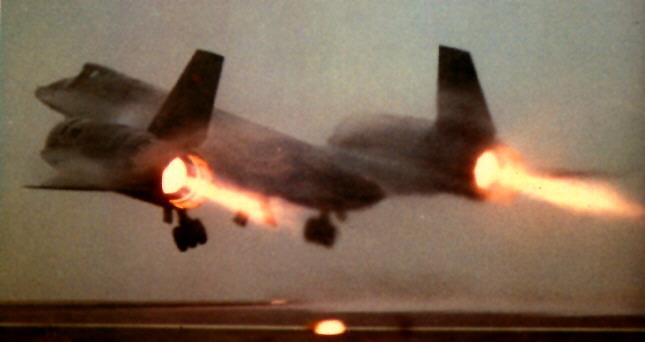
J-58 Pratt and Whitney Engine

J-58 Pratt and Whitney Engine
Specifications:
Model: Pratt & Whitney J-58JT11D-20
Compressor: 9-stage, axial flow, single spool Turbine: two-stage axial flow
Thrust: 32,500 lbs. with afterburner
Weight: approx. 6,000 lbs.
Max. operating altitude: above 80,000 ft.
![]()
The SR-71 Blackbird is powered by two Pratt & Whitney J-58 turbo-ramjets, each developing 32,500 pounds of thrust with afterburning. The critical problems concerning supersonic flight with air breathing engines are concentrated in the air inlet area. The circular air intakes of the SR-71 contain a center body tipped with a conical spike. The spike is movable, forward for takeoff and climb to 30,000 feet after which, as speed builds up, it moves rearward, controlling the amount of air entering the engine. As it does so, Air Inlet Bypass Doors in the side of the nacelle close to establish the correct flow of air through the engine, holding the supersonic shock wave in it's critical position within the inlet. The engine itself operates at subsonic speed. At Mach 3+ the spike is three feet to the rear of it's takeoff position, slowing down the incoming airflow, establishing an area of pressure within the nacelle, which is now pushing the engine. This action is so powerful that it accounts for 58 percent of the total thrust, the engine providing only 17 percent, and the ejectors (surrounding the nacelle near the afterburner) is responsible for the remaining 25 percent. Should the shockwave be expelled from the inlet, a condition known as an "Unstart" occurs. Unstarts have been known to be so violent as to crack the pilots helmet from the severe yaw of the aircraft. If unchecked, the resulting yaw is described by SR-71 pilots as though the nose and tail are trying to swap ends. However, an automatic control system senses this problem and repositions the Spike in milliseconds, doing so with great accuracy even though air loads of up to fourteen tons are acting on the spike, dealing with the difficulty before the human brain becomes aware of the problem, and the Blackbird cruises on....faster than a rifle bullet.
A correction to the above paragraph is needed. Ken Hall, a retired Astro/Aero/Electronic engineer states: It appear from this description that FREE thrust is being generated by the pressurized air behind the inlet shocks. Not true. A portion of the "pressurized" incoming air flow was/is piped and valved around the rotational core to the afterburner section where fuel is added and combusted with this, so called by-pass, air thus producing thrust. An engine that functioned as you have described would be a free energy machine.
Ken Hall kenjack@hughes.net
Editors Note: Thank you for the clarification.
![]()
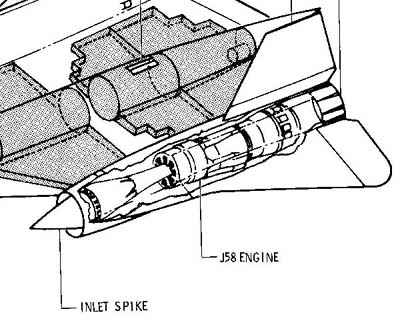
Cutaway Drawing
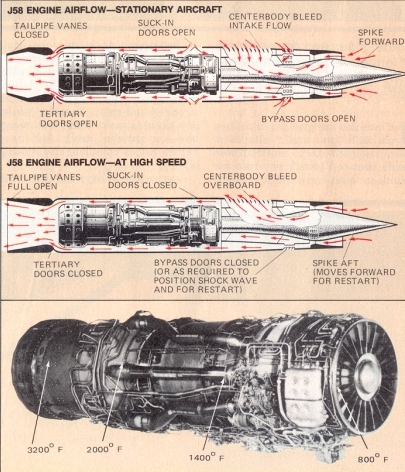
J-58 Airflow and Temperature Range
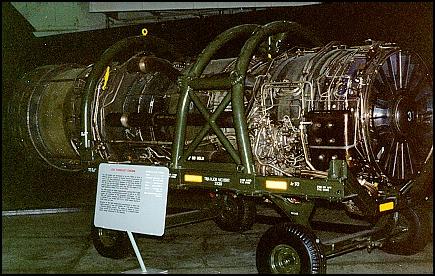
J-58 Engine on Display
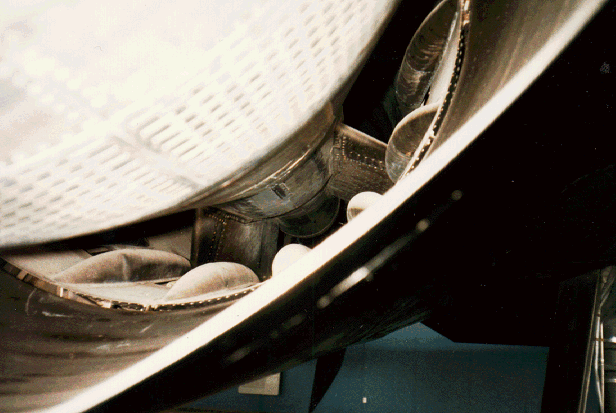
Close-up of J-58 Inlet with Spike Installed
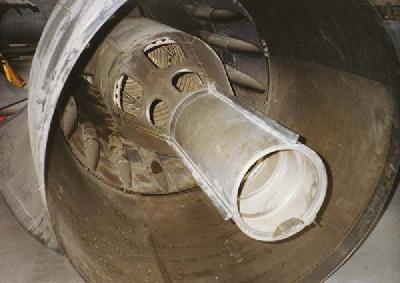
Close-up of J-58 Inlet with Spike Removed
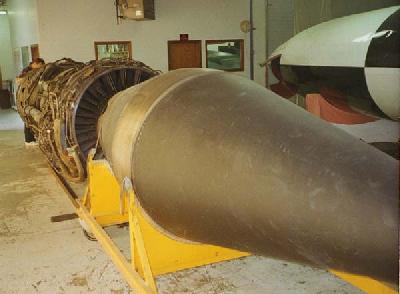
SR-71 Spike and J-58 Engine

SR-71 J-58 Engine In Afterburner on the Test Cell at Beale AFB, Ca.
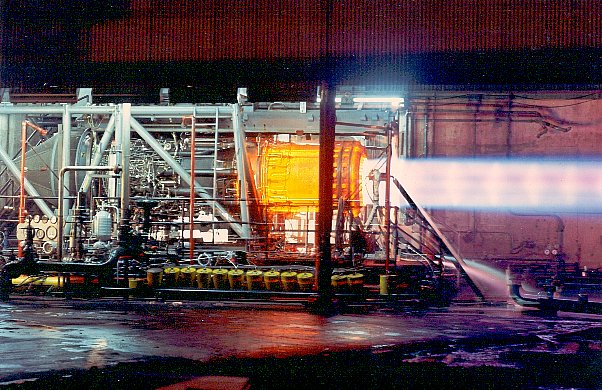
J-58 Engine Testing in Afterburner at test cell A-1 at Pratt and Whitney’s West Palm Beach facility.
October 15, 2008 Kurt Schmidt
I recently came across your
website an enjoyed it immensely. I did notice the picture on the J58 page
captioned as “J-58 Engine Testing in Afterburner at Lockheed Martin
Corp.”. This is incorrect. The picture actually shows test cell A-1 at
Pratt and Whitney’s West Palm Beach facility. I had the pleasure of working
this test cell in the mid 1980’s. This test cell was actually an altitude
simulation cell used for testing purposes. (We had a additional cell used for
sea level runs for motors which were overhauled onsite also.) It used a
non-afterburning J-79 as a slave motor. The exhaust of the slave was introduced
to the inlet of the J-58 through a series of valves thereby simulating the
speed, temperature, and density of the air at the inlet normally seen during
flight. In this particular picture the motor is running at sea level as
indicated by the inlet screen. I spent many hot and humid nights servicing,
mounting, and running this particular cell. I was one of a crew of five. Some of
the greatest co-workers I have ever had the privilege to of worked with. Sadly,
the cell is no more. It didn’t go without a fight though. The contractor had
to repeatedly repair his demolition equipment saying it was the hardest concrete
he had ever had to remove. Sincerely,

Shock Diamonds shown in Afterburner at Night
![]()
The first J-58s delivered to the blackbird program, all three models,
had all stainless steel lines and the oil tank gold plated, the reason
was for better heat dissipation. After a couple of years, and the subsequent
tear down of engines, it was noted there was an abnormal amount of corrosion
caused by dissimilar metal electrolysis. The gold plate was removed because
the heat dissipation properties did not out weigh the cost of replacing
lines as they started leaking.
Side note: When #957 crashed off the North end of the runway at
Beale AFB and pictures were published, the hew and cry that came from the
civilian segment about all the gold that was on the engine caused quite
a commotion, even when it was explained why the gold was there. (Info courtesy
Ron De Lozier)
An In-Depth Article on the J-58 Engine Lineage
by Philippe Ricco
Fri, 19 Jul 2002 08:18 Philippe Ricco Writes: 15 years ago, when I was
a student and very impressed by the beautiful Blackbird, I wrote some personal notes about
the Pratt & Whitney J-58. Years after, as Aeronautics Engineer, I found some more
information to add to these notes. Recently, I gave the first part of these notes to one of my friends for publishing on the
WEB, at the following address:
http://aerostories.free.fr/technique/J58/J58_01/page8.html
| SR-71 Front Page | Links Page | Index Page | Recollections | 2001 Reunion |
| "SR-71 Blackbirds" Web Site Navigator | ||||
| First Created: April 15, 1996 - Last Revised: March 29, 2004 | ||||
| Copyright © 1996 Leland R. Haynes Email: sr71webmaster@sr71.us | ||||
Page #13 of the "SR-71 Blackbirds"